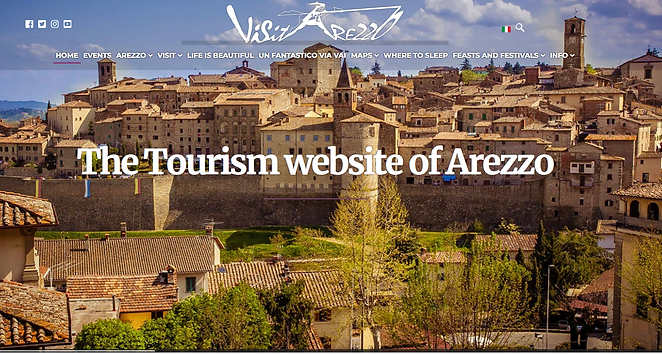
Arezzo - Provincial Capital
The city of Arezzo is a little-known gem for those seeking an authentic and in-depth experience of Italian culture and art. With its cobbled streets, historic squares and ancient palazzi, Arezzo is a paradise for lovers of art, history and architecture.
Arezzo has a history of art that dates back to the Etruscan and Roman times. But it was during the Middle Ages and the Renaissance that the city reached its greatest splendor, thanks to the noble families who invested in the creation of works of art and architecture.
Arezzo Cathedral, built between the 13th and 14th centuries, houses numerous masterpieces from different periods and by different artists, including Piero della Francesca's fresco with the solemn figure of "Mary Magdalene", probably painted in 1459.
The landmark of Arezzo is the Basilica of San Francesco, one of the most important Franciscan churches in Italy. Here you can admire one of the masterpieces of the Italian Renaissance: the Legend of the True Cross by Piero della Francesca. This fresco is one of the most important and famous works of art in the history of Italian art. In the town of Sansepolcro, not far from Arezzo, there is also a museum with the most famous works of Piero della Francesca.
The Palazzo della Fraternità dei Laici, with its Gothic facade, is another architectural wonder of Arezzo.
Petrarch’s house is the birthplace of one of the greatest poets of Italian and international literature: Francesco Petrarca, along with Dante Alighieri and Giovanni Boccaccio, the father of Italian language and literature. When Petrarch was born on July 20, 1304, Dante is said to have been in the city and to have found refuge within these 14th century walls with Dante's father, his great friend Ser Petracco. Both had been banished from Florence. Today the house houses the museum of the same name and the Accademia Petrarca di Lettere Arti e Scienze. It has paintings by Tuscan painters from the Renaissance, Petrarch objects, a numismatic collection with about 250 ancient coins, and a library with works and volumes on Petrarchism, a cultural movement that arose around 1600 around the figure and work of the genius. The terrace of the 14th-century house offers views of the Prato in front of the Fortezza Medicea, where the marble statue dedicated to Petrarch stands, in addition to medieval towers. Since 2011, the upper floors of the building have housed the D.I.M.A. Academy.
Guido d'Arezzo, also known as Guido Monaco, is known worldwide as the inventor of musical notation. As a Benedictine music teacher in the Abbey of Pomposa (Ferrara) and in the Cathedral of Arezzo, he invented a system that for the Middle Ages (we write the year 1000) represented a real revolution in the history of Western music, making it possible to disseminate cultivated music outside the monasteries and make it accessible to all. His experiments in the field of notation of Gregorian chants, which were difficult for the members of the Scholae Cantorum to memorize and intonate, met with much resistance, but in Arezzo he found refuge and protection with Bishop Tebaldo, the dedicatee of his most popular tract and musical text in the Middle Ages: Micrologus. Arezzo and its territory have always been closely linked to the figure of the Benedictine monk: The square dedicated to him in the center of the city appears as the antechamber of ancient Arezzo, one of the most important meeting points and crossroads in the heart of the ancient city walls, among the remains and monuments of Roman, medieval and Renaissance history. But there are also traces of the presence and activity of Guido d'Arezzo in the province, especially in Casentino. In the village of Talla you can visit the Casa Natale (birthplace), where a documentation and educational trail has been set up with ancient instruments and illuminated manuscripts from the nearby monastery of La Verna. An interactive musical tour, the Via Musicalis, curated by artist Marco Ermini, connects the museum to the nearby medieval village and features sound installations and more.
Casa Vasari was purchased by the genius Giorgio Vasari in 1541 and today houses the museum of the same name. The house consists of three floors: a basement, the stately home on the second floor and a second floor, which was probably intended for the servants. The jewel is the garden with its central geometric structure and the numerous pictorial decorations that Vasari personally took care of, testifying to the artist's intention to celebrate art, artists and himself. In 1687, Vasari's last descendant bequeathed his estate in his will to the Fraternita dei Laici, and in 1911, the year of the artist's four hundredth birthday, it reverted to state ownership to be used for the Vasari Museum.
In addition, Arezzo is known for its antiques market, which takes place every first Sunday of the month. Here you can find antique treasures such as furniture, paintings, art objects and ceramics displayed in the streets of the historic center.
Arezzo is also famous for its traditions, such as the Giostra del Saracino, an event that takes place twice a year (in June and September) where knights on horseback compete for the golden lance for their borough.
